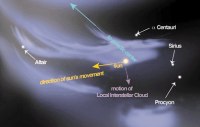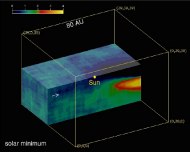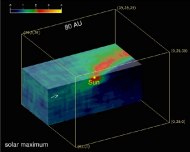Ulysses sees Galactic Dust on the rise
1 August 2003
Since early 1992 Ulysses has been monitoring the stream of stardust flowing through our Solar System. The stardust is embedded in the local galactic cloud through which the Sun is moving at a speed of 26 kilometres every second. As a result of this relative motion, a single dust grain takes twenty years to traverse the Solar System. Observations by the DUST experiment on board Ulysses have shown that the stream of stardust is highly affected by the Sun's magnetic field.
 |
|
The Sun and the nearest stars move through filaments of galactic clouds (figure by P. C. Frisch, University of Chicago). |
The reason for the weakening of the Sun's magnetic shield is the increased solar activity, which leads to a highly disordered field configuration. In the mid-1990s, during the last solar minimum, the Sun's magnetic field resembled a dipole field with well-defined magnetic poles (North positive, South negative), very much like the Earth. Unlike Earth, however, the Sun reverses its magnetic polarity every 11 years. The reversal always occurs during solar maximum. That's when the magnetic field is highly disordered, allowing more interstellar dust to enter the Solar System. It is interesting to note that in the reversed configuration after the recent solar maximum (North negative, South positive), the interstellar dust is even channelled more efficiently towards the inner Solar System. So we can expect even more interstellar dust from 2005 onwards, once the changes become fully effective.
 |
 |
|
These pictures show cut-aways of where interstellar dust is concentrated in the Solar System (the planets are not shown). Higher concentrations are depicted in red/yellow and lower concentrations are depicted in blue/green. | |
While grains of stardust are very small, about one hundredth the diameter of a human hair, they do not directly influence the planets of the Solar System. However, the dust particles move very fast, and produce large numbers of fragments when they impact asteroids or comets. It is therefore conceivable that an increase in the amount of interstellar dust in the Solar System will create more cosmic dust by collisions with asteroids and comets. We know from the measurements by high-flying aircraft that 40 000 tonnes dust from asteroids and comets enters the Earth's atmosphere each year. It is possible that the increase of stardust in the Solar System will influence the amount of extraterrestrial material that rains down to Earth.

